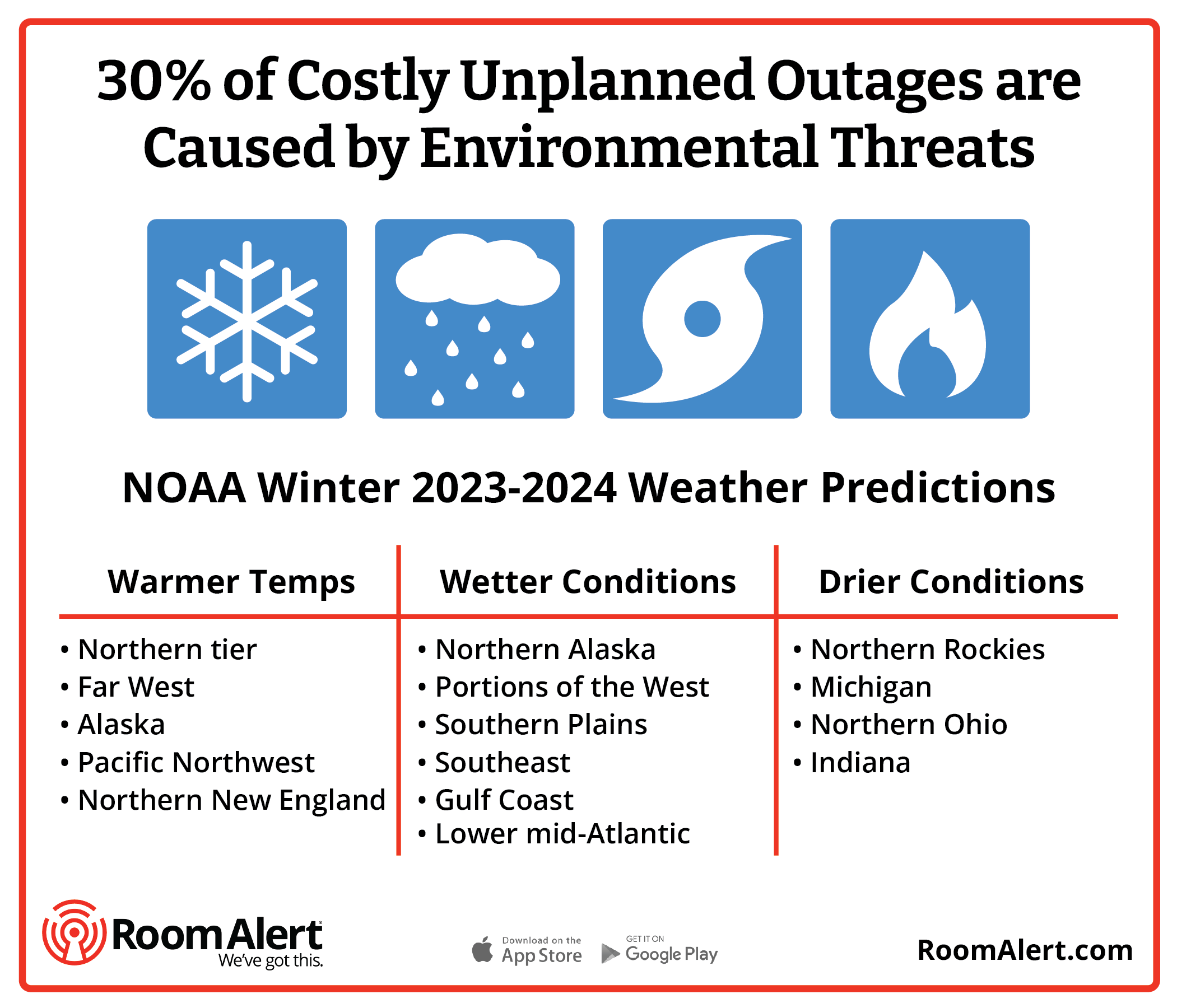
Knowledge Base / News
The NOAA’s National Weather Service provides weather, hydrologic, and climate forecasts and warnings for the United States, its territories, adjacent waters and ocean areas, for the protection of life and property and the enhancement of the national economy.
A few months ago, we explored the National Oceanic and Atmospheric Administration’s (NOAA) Fall 2023 Predictions. As we bid farewell to this year and look ahead to the coming one, let’s revisit NOAA’s winter 2023-2024 predictions to glean insights into what lies ahead and how to best prepare.
Seasonal outlooks play a crucial role in helping communities brace for upcoming months, minimizing the impact of weather on lives and livelihoods. With winter weather already upon us in the northern hemisphere, it’s a critical time for businesses, facilities, and organizations of all sizes to understand potential threats posed by extreme or unexpected weather conditions.
Freezing cold temperatures, storms, freezing rain, sleet, snow, ice and high winds are just some of the conditions that can cause irreversible damage and even force you to close your doors for good. To help us navigate this time of year, we turn to the NOAA for their Winter 2023-2024 Weather Predictions.
 This year, the presence of El Niño heading into winter for the first time in four years shapes the outlook. NOAA predicts warmer-than-average temperatures for the northern tier of the continental United States and much of the Far West. The highest odds for warmer conditions are in Alaska, the Pacific Northwest, and northern New England.
This year, the presence of El Niño heading into winter for the first time in four years shapes the outlook. NOAA predicts warmer-than-average temperatures for the northern tier of the continental United States and much of the Far West. The highest odds for warmer conditions are in Alaska, the Pacific Northwest, and northern New England.
From December through February, NOAA anticipates wetter-than-average conditions for northern Alaska, portions of the West, the southern Plains, Southeast, Gulf Coast, and lower mid-Atlantic. Conversely, drier-than-average conditions are expected across the northern tier of the U.S., especially in the northern Rockies and High Plains and near the Great Lakes. The greatest odds for drier-than-average conditions are forecast in portions of the northern Rockies and central Great Lakes region, particularly for Michigan and northern Ohio and Indiana.
Widespread extreme to exceptional drought persists across much of the South and portions of the central U.S. NOAA, in collaboration with the National Integrated Drought Information System (NIDIS), continues to monitor ongoing drought conditions in the southern and central U.S. and worsening drought in Hawaii. The forecast indicates improvement in drought conditions across the Southeast, the Gulf Coast, and Texas due to the expected wetter-than-average weather.
The best way to tackle environmental threats before they unfold into disaster is with Room Alert environment monitoring. 30% of costly unplanned outages are caused by environmental threats like those listed above. The Room Alert platform consists of monitors, sensors and accessories that proactively oversee the conditions in your environment. Room Alert hardware pairs perfectly with Room Alert software to promptly notify you and your team of environmental changes that could result in an unexpected outage, damage or even bankruptcy.
Unexpected power outages, for example, are a common threat to routine business operations throughout the winter season. From 2000-2021, there were roughly 1,542 weather-related power outages. Most outages were caused by winter weather (22%), tropical cyclones (15%), and other severe weather (58%). While losing power due to winter storms may be unavoidable, Room Alert can alert you when your facility loses power, enabling your team to respond promptly and effectively.
As we approach the winter 2023-2024 season, staying informed and taking necessary precautions to mitigate weather-related threats is essential. Room Alert stands as a cost-saving superhero, empowering businesses to thrive, even in the face of uncertainty.
If you have any questions or want additional information, please contact us today via email at Sales@RoomAlert.com, through our online Live Chat service, or by phone at 401.628.1600.

You may find Windows Command Prompt at the following path:
To run Windows Command Prompt as an administrator:
| Current S models | Current E models |
|---|---|
| Room Alert 32S | Room Alert 32E |
| Room Alert 12S | Room Alert 12E |
| Room Alert 3S | Room Alert 4E |
| Room Alert 3E | |
| S models | E & W models |
|---|---|
| Room Alert 32S | Room Alert 32E |
| Room Alert 12S | Room Alert 12E |
| Room Alert 3S | Room Alert 4E |
| Room Alert 3E | |
| Room Alert 3W |
| Model |
|---|
| Room Alert MAX |
| Room Alert 32S |
| Room Alert 12S |
| Room Alert 3S |
| Room Alert 32E/W |
| Room Alert 12E |
| Room Alert 4E |
| Room Alert 3E |
| Room Alert 3 Wi-Fi |